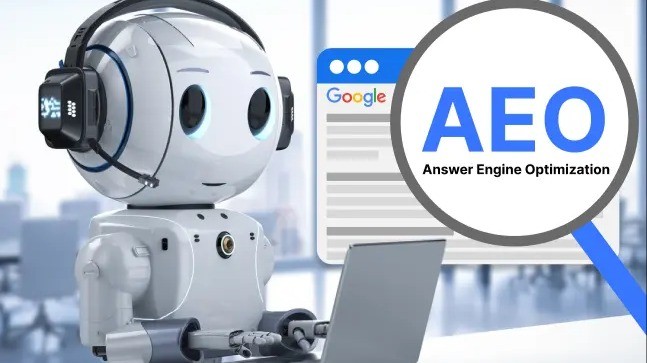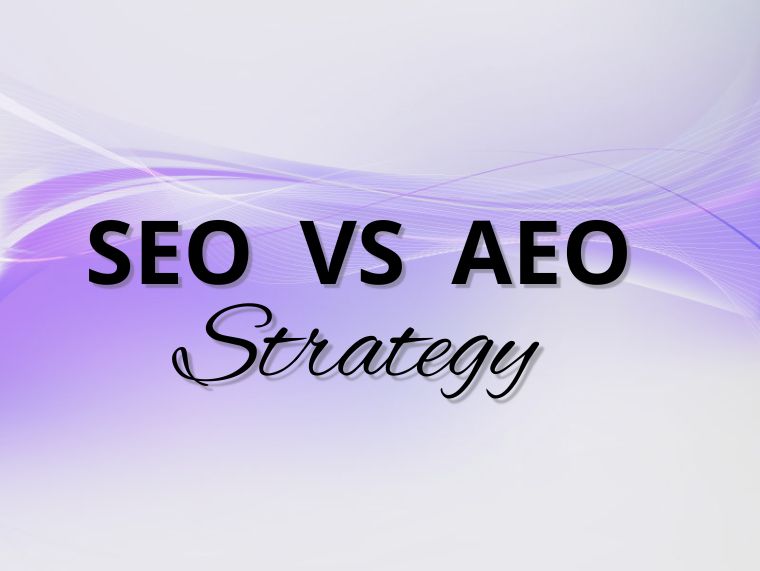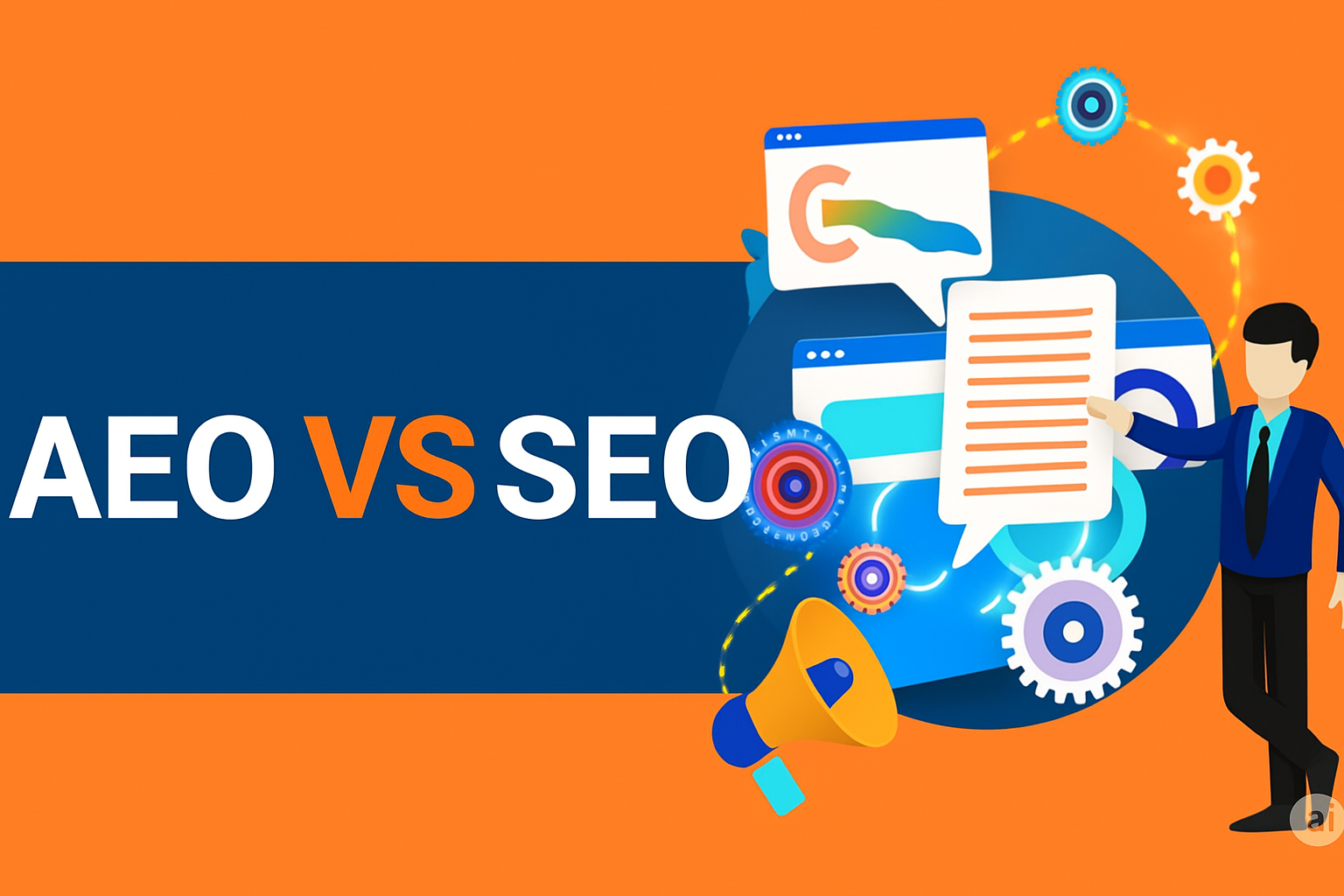Introduction
Digital marketing is facing a nearly shape-shifting climate, and businesses are eagerly set to find out how they could achieve better and more powerful online visibility and presence. The pursuit of these objectives has been such that the derivations in major strategies are SEO and AEO. Then in this you will get to know AEO vs SEO for your business.
While top SEO strategies has conventionally been at the heart of digital marketing, AEO will attain significance with the rising star that is voice search and AI-driven technologies. Both do ensure that business houses increase their visibility, though each does it in a very different manner, being designed for distinctly different digital ecosystems.
Knowing how both SEO and AEO work and support each other will be the key with the world of digital transition toward conversational and AI-driven search experiences for any business that wants to survive in this digital era.
Diving into the blgo let’s have a quick review on aeo vs seo :
| Aspect | SEO (Search Engine Optimization) | AEO (Answer Engine Optimization) |
|---|---|---|
| Definition | SEO is the process of optimizing a website to rank higher on search engine results pages (SERPs) like Google or Bing. | AEO focuses on optimizing content so that it appears as a direct answer in voice searches or AI-powered results (like Google Assistant or ChatGPT). |
| Goal | To increase visibility and drive organic traffic from search engines. | To provide clear, concise, and structured answers that search engines and AI can easily understand and use. |
| Primary Audience | Human users searching online through browsers. | AI assistants, voice search tools, and answer engines responding to user queries. |
| Content Focus | In-depth articles, blogs, and optimized web pages with keywords and backlinks. | Short, factual, and conversational answers optimized for featured snippets or voice results. |
| Optimization Techniques | Keyword research, link building, on-page optimization, technical SEO, and user experience. | Using structured data, schema markup, FAQs, and concise language that directly answers specific questions. |
| Search Intent | Informational, transactional, navigational, and commercial intent. | Primarily informational—focused on providing quick and accurate answers. |
| Example | Optimizing a blog to rank for “Best Trekking Companies in Nepal.” | Structuring content to answer “What are the best trekking companies in Nepal?” directly in search or voice results. |
| Output | Web pages appearing in the search engine results page (SERP). | Direct answers shown in voice search or AI-generated responses. |
| Future Focus | Still important for traditional web searches. | Growing rapidly with AI assistants and voice search becoming more popular. |
What is AEO (Answer Engine Optimization)

AEO stands for Answer Engine Optimization, a strategy of optimizing content to be directly identified and utilized by AI-driven platforms and voice search assistants like Google Assistant, Siri, Alexa, and Cortana.
Basically, AEO has the core task of ensuring content is structured and formatted in such a way as to make extraction by AI-powered engines simple and direct to user queries.
While traditional SEO is all about better rankings of a website in the search engine results pages (SERPs), AEO builds upon upgrading the content to make it search frictionless and visible in AI-generated answers, or “featured snippets,” knowledge panels, and quick answers.
This is the type of results that typically appear at the top of a search and, therefore, are the most visible and accessible to users.
Key elements of AEO include:
- Structured Data & Schema Markup: In addition, content may be marked up with specific coding-so-called schema.org-for AI assistants to then understand the content correctly. Examples include providing direct answers to FAQs, using “how-to” markup for instructional content, or marking business information such as location and hours of operation.
- Answer-Oriented: Content should be short and concise, mostly in the form of short, direct answers, emulating exactly how people would speak when asking questions through voice search.
- The difference is the queries are a little different, for example. It’s generally wordier and question-based, such as “How do I make spaghetti?” instead of “spaghetti recipe.” AEO also optimizes the content by targeting these types of natural language queries.
- Featured Snippets and Position Zero: AEO focuses on content that shows up as the number one direct answer on a search result page, position zero. These snippets come in the format of paragraph answers, lists, or tables, which are pretty easy for AI assistants to read and deliver.
AEO is very crucial for any business to benefit from voice searches, where a user wants a quick and trustworthy answer to whatever he says against AI. With the appearance of smart speakers, smartphones, and other gadgets with voice, AEO has become vital in the field; this means prominence in voice-driven searches for branded content.
What is SEO (Search Engine Optimization)?

SEO, or Search Engine Optimization, remains the bedrock of digital marketing. The goal of SEO It involves increasing the visibility and authority of a website in traditional search engines like Google, Bing, and Yahoo for high ranking relevant queries in their search results. Optimization of a website and its content in the search engines will surely drive organic traffic and lure potential customers to businesses.
SEO entails a few techniques, but it can largely be grouped into on-page SEO, off-page SEO, and technical SEO.
- On-Page SEO: Work done on every page to make them more search engine-friendly includes the following:
- Keyword Placement: Identifying proper keywords and placing them in strategic areas, which include titles, headings, meta descriptions, and within the body of the content.
- Meta Tags & Descriptions: Remarkable meta descriptions and the effective use of title tags will make pages more appealing to both search engines and users.
- Internal Linking: Building internal linking to guide the search engine through the site and improve the crawlability of pages.
- User Experience (UX): Make sure the content is qualitative, readable, and adds value to the user.
- Off-Page SEO: This refers to those actions that are done outside the website but have an impact on its authority and ranking. Among such key elements of off-page SEO are building backlinks from authority and relevant sites.
The backlinks are like a vote of confidence that other sites use to signal to search engines that your content is trustworthy and reliable.
- Technical SEO: It means optimizing the technical factors of a website to improve the performance and crawlability of the search engines. The key factors include:
- Site Speed: Faster loading websites offer a better user experience and rank higher in the search results.
- Mobile-Friendliness: Since mobile devices have become common nowadays, having a mobile-responsive website is crucial to ranking well in search engines.
- Structured Data: Implementing schema markup to provide additional context and information to search engines, helping them understand content more accurately.
- Crawlability: Ensuring that search engine crawlers can easily navigate and index your site’s pages without encountering technical issues.
The Shift from Traditional Search to AI-Driven Answers
The change from traditional search to AI-powered answers is actually changing the way users seek out information. Thanks to voice and AI assistants, users now want instant answers delivered in conversational tones, not sifted from multiple search results.
This means businesses need to adopt AEO, which involves structuring content in a manner that will enable AI platforms to extract and deliver concise, direct answers. Optimizing for AEO enhances the chances of showing up as featured snippets or as a voice response in voice searches. With the growth of AI-powered search, AEO is crucial for visibility in this changing digital environment.
The Increasing Role of AI Assistants: Google Assistant, Siri, Alexa
With the likes of Google Assistant, Siri, and Alexa, even the way information is sought after is being redefined. Today, instead of scrolling through results pages, users leverage assistants to get direct, voice-activated answers to their queries. This new behavior requires businesses to optimize content for AI platforms through structured data and featured snippets.
As these assistants find their way into everyday devices, businesses need to ensure their content is ready to be pulled for that top answer in AI responses. The path forward in voice-first search requires optimization for AI-driven platforms.
The Evolution of Search: From Keywords to Answers
The search engines have quickly moved from a keyword-based approach to natural language processing and understanding context with updates like BERT, MUM, and Hummingbird by Google.
These updates enabled Google to know user intent—what lies beneath the intent of the query and not just the matching of keywords. This shift brings a larger emphasis on content that answers the intent of a user, migrating businesses from conventional SEO tactics toward Answer Engine Optimization.
The Rise of Zero-Click Searches
Zero-click searches are more common, and that’s where users get an answer within the search results themselves and don’t need to go on a website to find the same. This keeps happening with featured snippets, knowledge panels, and AI-powered answers that provide, right at the top of the page, instantaneous, short-length answers.
For example, a searched question like “How to optimize content for SEO?” may feature a direct answer box instead of having to be clicked on the link. Since this trend would reduce the influx of users, it is important for businesses that their content are optimized for Answer Engine Optimization, AEO.
AEO involves structuring content in such a way that the search engines will easily pick and display as a direct answer. By focusing on AEO, businesses are able to get hold of high-value visibility through these positions, driving brand exposure even in cases where users don’t actually click through to the website.
Voice Search Trends and Their Influence on Search Strategies
Voice search queries tend to be longer, conversational, and question-based. This shift impacts SEO strategies, requiring businesses to optimize content for voice search by providing concise, structured answers that AI can process easily.
Why AEO is Gaining Importance
Several factors contribute to the growing importance of AEO:
- Increase in AI-driven search queries: AI-powered search engines and assistants rely on structured data.
- Rise of smart assistants and voice search: More users depend on Google Assistant, Siri, and Alexa for information.
- Google’s focus on featured snippets and knowledge panels: Google prioritizes direct answers over traditional web results.
- Shift in user preference: People want fast, reliable answers without clicking multiple links.
SEO Strategies vs AEO Strategies

SEO Optimization Tactics
Keyword Research & Placement
Effective keyword research identifies terms with high search volume and relevance to a target audience. Strategically placing these keywords throughout your content—within titles, headings, meta descriptions, and body text—helps search engines understand the focus of your page and rank it higher in search results. Keywords should be integrated naturally to maintain readability.
Link Building and Domain Authority
Link building involves earning high-quality backlinks from reputable websites. Backlinks act as endorsements, signaling to search engines that your content is credible and valuable. High-quality backlinks improve your domain authority, which, in turn, increases your website’s rankings. Building relationships with authoritative sites and creating shareable content are essential strategies in this process.
Technical SEO
Technical SEO focuses on optimizing the backend of your website. This includes improving site speed, ensuring mobile optimization, and making your website indexable by search engines. Fast-loading pages and mobile-friendly designs improve the user experience, while proper indexing ensures search engines can crawl and rank your content efficiently.
AEO Optimization Tactics
Implementing Structured Data (Schema Markup)
Schema markup is a type of structured data that helps search engines understand the context of your content. By adding Schema.org markup to your website, you can provide search engines with information about your business, events, products, and more. This makes it easier for AI-driven platforms to display your content in featured snippets, knowledge panels, and other rich results.
Writing Content for Featured Snippets
Featured snippets are the direct answers that appear at the top of search results. To optimize for this, structure your content in a clear, concise question-and-answer format. Use bullet points, numbered lists, and short paragraphs to make it easy for AI to extract and display your content in a snippet. Address common questions relevant to your audience and provide straightforward, factual answers.
Optimizing for Voice Search
With the rise of voice search, optimizing content to align with conversational queries is essential. Voice search queries are typically longer, question-based, and more natural in tone. To optimize for voice search, create content that mimics how people speak, addressing common, everyday questions. Focus on providing direct, concise answers and ensure your content aligns with common voice search patterns to increase your chances of being featured in voice search results.
How to Optimize for Both AEO and SEO
Balancing SEO and AEO is crucial for digital success. Follow these steps:
- Write detailed yet concise content to satisfy both long-form readers and AI-driven searches.
- Use Q&A format to increase the chances of ranking for featured snippets.
- Enhance credibility by citing authoritative sources.
- Optimize for mobile and voice search to align with modern search behaviors.
The Role of AI in AEO and SEO
How AI Algorithms Process and Rank Content
How AI Algorithms Process and Rank Content
Google uses different cutting-edge, AI-powered algorithms in processing and ranking content for results that are increasingly more accurate, oriented toward users’ intents, and user-focused. Of them, three major models start with BERT, RankBrain, and MUM, each independently having different powers that make searching superior.
- BERT (Bidirectional Encoder Representations from Transformers):
BERT is going to help Google understand the context of words better in a sentence. While previous models focused on processing one direction-text in either left to right or vice versa, this model looks for the complete contextual understanding of the word by keeping its surroundings into consideration.
That makes it much better at understanding natural language, especially in longer, more conversational queries. Such queries-like “Can you get medicine for a cold at a pharmacy?”-are better understood by BERT, as it understands the context of “cold” with respect to “medicine” to return much more relevant results.
- RankBrain
RankBrain is a computer algorithm that helps Google understand what its users want when they enter a search query. It uses machine learning to better understand and categorize new search terms-that it hasn’t encountered before.
RankBrain processes how users interact with the search results to refine the ranking to show more relevant content. Such as when a user enters a query that is ambiguous or uncommon, RankBrain can look at similar queries and match the most accurate results based on the pattern of user behavior.
- MUM (Multitask Unified Model)
MUM represents some of the latest and most powerful artificial intelligence models in the possession of Google; these were engineered to tackle especially complex and multicomponential queries with thoroughly worked out answers. It understands the contents of videos, images, or different language content by perceiving any language when doing it.
For instance, if a user asks, “How do I learn to play the guitar and then be better at playing the guitar?”, MUM has the capability of retrieving information on many aspects such as articles, tutorials, or even videos that best combine in one rich response. Unlike typical models that stick to single queries, MUM tackles multi-stage questions and presents far more contextual depth.
These together revolutionized how Google ranked content, going way beyond traditional parameters and closer to the actual needs and context in which users were making those queries. To rank high on this evolving system, businesses must optimize content in ways that cater to these AI models by being focused on natural language, answering multi-faceted questions, and understanding user intent.
The Impact of AI-Powered Search Engines
AI-driven search engines, like ChatGPT and Google’s Bard, transform the way users look for information. They make use of enhanced NLP, offering direct answers instead of results lists. Users can now ask complex, conversational questions, and AI systems respond with relevant, concise information.
It has shifted to make the task of AEO very critical for businesses to remain visible; with AI-driven responses now emerging, businesses need to optimize their content to be understandable and extractive by these AI systems.
This means structuring the content in terms most understandable by AI algorithms and embedding schema markup within that content for maximum visibility. AEO makes businesses more likely to appear as the source of answers at the top of search results powered by AI, and help businesses be highly visible, thereby driving more engagement in a changed digital paradigm.
AEO vs SEO: Which One Should You Prioritize?
So, it is up to one’s goals and audience in choosing either SEO or AEO.
- If your main focus is organic traffic through traditional search engines like Google, then focus on SEO. SEO is important for those businesses that want to rank high in the search engine results page, better known as SERPs, and for long-term visibility.
SEO strategies, including keyword optimization, backlink building, and technical SEO, will always be the basics needed for driving traffic to the website, crawlability, indexation, and proper search engine ranking.
- Prioritize AEO if a target audience largely relies on voice searches and AI-driven answers. With the fast-growing digital assistants like Google Assistant, Siri, and Alexa, Answer Engine Optimization ensures that the content is modeled for direct answers. AEO helps businesses show themselves as go-to sources with AI-driven answers, ensuring top visibility in results from voice search and featured snippets.
If your audience uses voice search frequently or expects instant answers from AI, AEO might be a better way to increase your chances of being the first featured answer.
- Integrate Both for complete digital visibility. As the digital space keeps on changing, the dividing line between SEO and AEO is getting blurred. While SEO remains crucial for traditional search traffic, AEO holds the key to visibility in voice searches, AI-driven responses, and zero-click searches.
By combining the two strategies, businesses can ensure that all bases are covered in their effort to reach their audience, whether through typing their queries into a search bar or by speaking to an AI assistant.
Future Trends: Will AEO Replace SEO?
With AI-driven technologies, such as ChatGPT and Google’s MUM, shaping how we search more and more, many wonder if AEO is the future replacement for SEO. No doubt, AEO is gaining greater importance with the increasing trend of voice search and AI-powered results, but it is not very likely that SEO will be fully replaced anytime soon.
- The AI-driven searches will keep increasing: With more users adopting voice assistants and AI-powered search engines, Answer Engine Optimization will be in great demand. Whereas these AI assistants give instant and direct answers, businesses have to rework their content to feed these systems so that they show up in featured snippets or voice search results.
- There may be an increase in the complete dependence of Google on pure AI over traditional ranking signals. Google, with constant improvements to the AI models-including RankBrain, BERT, and MUM-is likely to rely on AI-driven content understanding more heavily.
Already these models are concentrated on user intent, contextual comprehension, and natural language processing-so optimization of content should not just be for keywords but how AI interprets and ranks answers.
- Businesses should not forget to balance AEO with traditional SEO strategies. While AEO will continue to grow in prominence, traditional SEO is still imperative for long-term rankings, organic traffic, and strong domain authority.
In this voice search and AI-driven answer-oriented world, a business has to balance between technical SEO, content optimization, and AEO. AEO enriches and complements SEO on all levels and enables businesses to reach their audience through traditional search methods and via these emerging AI-driven platforms.
Ultimately, those businesses that can embrace both SEO and AEO strategies will be in the best position to thrive in a continuing complex and voice-first digital landscape.
Conclusion
Both SEO and AEO are crucial for a strong online presence. SEO helps drive traffic, while AEO ensures businesses can answer user queries directly. By integrating both strategies, businesses can stay ahead of digital trends and maximize their online reach.
FAQ on AEO vs SEO
Will AEO Replace SEO?
No, AEO will not replace SEO—instead, Answer Engine Optimization (AEO) complements SEO. SEO focuses on optimizing for search engines like Google, while AEO is about optimizing content for answer engines like Google’s featured snippets, voice assistants, and AI chatbots. In 2025 and beyond, using both AEO and SEO is essential for maximum online visibility.
What Is the Difference Between AEO and SEO?
| Feature | SEO (Search Engine Optimization) | AEO (Answer Engine Optimization) |
|---|---|---|
| Focus | Ranking on search engines (Google, Bing) | Appearing in featured snippets, voice results |
| Target User Intent | Informational, navigational, transactional | Question-based, conversational |
| Optimization Format | Keywords, meta tags, backlinks | Direct answers, structured content, schema |
| Output Type | Web page links | Quick answers, summaries, rich results |
Key Difference:
SEO gets clicks, AEO gets answers.
SEO drives traffic; AEO builds trust instantly in voice and AI-driven environments.
What Is Replacing SEO?
Nothing is replacing SEO entirely, but it’s evolving. In 2025, SEO is merging with:
- AEO for voice and AI-driven search results.
- Semantic search and entity-based optimization.
- Experience signals (UX, Core Web Vitals).
- Multimodal search (text, image, voice).
So, SEO is not dying—it’s becoming smarter and more user-centric.
What Is the Difference Between SEO Geo and AEO?
- Geo SEO (Local SEO):
Focuses on ranking your business for location-based searches, e.g., “yoga retreats in Pokhara” using local keywords, Google Maps, and reviews. - AEO (Answer Engine Optimization):
Focuses on answering specific user questions to appear in AI/voice search responses.
In short:
Geo SEO = “Where?”
AEO = “What?” or “How?”
What Is AEO vs SEO?
AEO vs SEO:
- SEO = Optimizing pages for ranking.
- AEO = Optimizing content for answering.
Use SEO to get found.
Use AEO to get featured.
Both work together—SEO brings users to your site; AEO answers their query immediately via rich snippets or AI tools.
Does SEO Still Matter in 2025?
Yes, SEO absolutely matters in 2025.
However, the approach has shifted:
- AI tools now summarize content.
- User intent and topical relevance are key.
- Websites need expertise, experience, authority, and trust (E-E-A-T).
SEO remains essential for visibility, while AEO boosts credibility in AI-first search environments.
Is SEO Dead Due to AI?
No, SEO is not dead due to AI.
Instead, AI has transformed SEO:
- AI curates and rewrites search answers.
- Search engines like Google and Bing are now also answer engines.
- SEO must adapt with AEO, schema markup, and better content structure.
Conclusion:
AI hasn’t killed SEO—it has made it smarter and more answer-focused.
How to Rank on AEO?
To rank in AEO (Answer Engine Optimization):
- Answer specific questions clearly.
- Use H2/H3 headings with question-based keywords.
- Structure answers in bullet points, tables, or short paragraphs.
- Add FAQ schema markup.
- Use conversational and concise language.
- Ensure content is factually accurate and easy to understand.
- Focus on voice search phrases like “How,” “What,” “Best,” and “Why.”
Pro Tip:
Write for zero-click results—where your answer is read aloud or shown in a snippet without users needing to visit your site.

